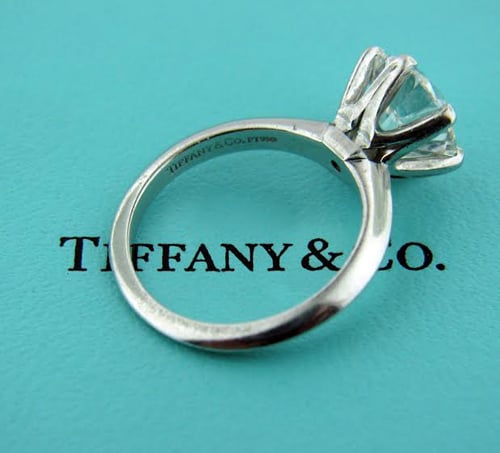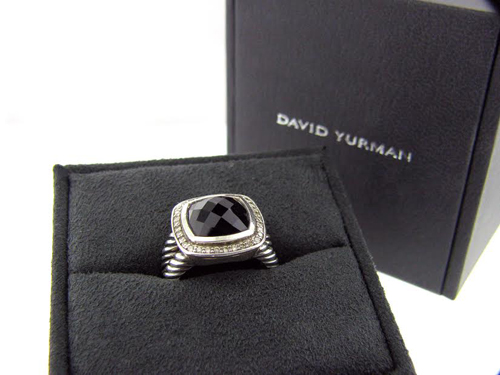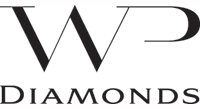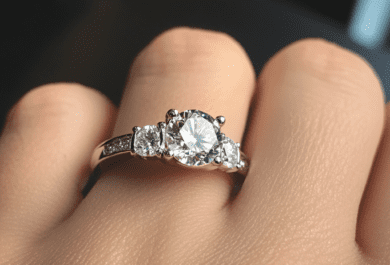
Tiffany solitaire diamond ring • photo by WP Diamonds
You bought a well-known branded jewelry item, and now you’re looking to resell it. How does the item fare in the secondary market? Does the brand’s consumer image translate to extra dollars for you? The brand’s equity value comes into play here.
Understand Brand Equity
Brand equity is partially built on the brand’s promise, the somewhat unspoken statement of “Best in Class.” Combining years of delivering their wares with a consistent high level and staying true to their mission statement, whether written or implied, brands build equity. In turn this equity helps command generally higher prices, which feed the aspirational desires of the consumer.
If you’re thinking of making a purchase in the jewelry arena, the brands that rank high with consumers are Tiffany, Cartier, Harry Winston, and the like. As you read the names of these famous retailers, their brand equity pops up without prompting. In the back of your mind you probably have a vision of a robin’s egg blue box or the red box of Cartier…Brand Equity!
Beyond the quality of the product, what these luxury retailers provide is the marketing message to support their image. Here is where packaging is their silent salesman. If you’ve been allured by the history, the quality and design of the product, the luxurious environment, and the pride of ownership, then you’ve been branded. Don’t get me wrong, I’m not saying it’s a bad thing. The point I’m making is that you paid a premium for the goods as well as all that comes along with it. The better quality along with the packaging carries forward with the brand equity.
What happens when you want to sell your branded jewelry piece?
If you continue to enjoy wearing the piece of jewelry you purchased, you always have the bragging rights that come along with the pride of ownership. However, should you for whatever reason desire to resell your special purchase, the brand makes no promise to buy it back. While the brand itself only sells “new,” there’s a world of buyers and sellers of pre-owned branded jewelry. This is where your brand’s equity repays you. Consider that as a buyer in the secondary market, you were intrigued with the notion of purchasing a previously enjoyed diamond engagement ring from “Tiffany & Co.” You as a buyer would want as many of the bells and whistles that the original purchaser received, minus the price and the storefront. The better the condition of the piece, with normal wear, is certainly the commanding issue of the secondary market’s price. However, you might be surprised that the added value of the original packaging (inside box, outside box, paperwork with folder, appraisal from the brand, original receipt) will bump the price upwards. That’s not to say that the market isn’t strong if the piece doesn’t have the box, etc. It’s just nice to know that if you’ve kept all the marketing material together, you’ll be rewarded for your efforts.

David Yurman ring • photo by WP Diamonds
Which companies can give you the best price for your jewelry piece?
Now it’s time to find those ads that say, “Sell Tiffany Jewelry” or “Sell Your Cartier Jewelry” and test the equity theory. Global companies like WP Diamonds are aggressive bidders on branded diamond and other jewelry. The approach is about the value of the piece on the secondary market as opposed to viewing the item intrinsically against non-branded similar items. Also, global businesses may be able to pay more (box or no box), as they may reach a broader market. Brands like Tiffany, Cartier, David Yurman, Harry Winston, and Van Cleef & Arpels, for example, repay the brand equity promise.
8 tips to help you sell your branded piece
Caring for your branded jewelry items will help you now and in the future. Jewelry and watches are meant to wear and enjoy, but like other luxury items, they need to be maintained. First, place the marketing material in a bag, and store it like your favorite cashmere sweater away from the elements. Next, be mindful that when you bang your hand on the table and hear metal you are doing damage to your ring. You get the point. Maintain and care for your jewelry and watches, and the effort will pay you back.
1. Do go online and explore your reselling options in addition to visiting brick and mortar stores.
2. Do save your original box, paperwork, certificates of authenticity, appraisal, and bags and store them to protect them from damage.
3. Do take clear photos of the item(s) from the top and sides. Also photograph the marketing material mentioned above.
4. Do research what the item currently sells for. (unless discontinued)
5. Do not panic if all you have is the item itself. Good buyers will still step up with an offer.
6. Original condition is key. If it’s used that’s OK. If it’s been abused or poorly repaired, it’s a problem.
7. Do seek an offer from someone who specializes in what you’re selling.
8. A global business will often pay a premium, because they have a bigger market.
by Michael Lebowitz
Director of Jewelry at WP Diamonds

Click here to discuss on the Forum














